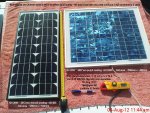A year ago I built a circuit to provide light in my chicken houses: http://www.picaxeforum.co.uk/showthread.php?19178-My-first-PICAXE-project-Chicken-lights-Greenhouse-watering&highlight=chicken
The 12V, 1.2 Amp-hour lead-acid battery is trickle-charged by a 2.4W solar panel. The 08M2 circuit senses light level using an LDR and switches on the lights (via a medium-power logic-level FET) for around an hour at dusk. The lights consist of a total of 4 x 3W LED strips, one each in 2 smaller houses and 2 in the larger house.
This works great most of the year, but in Winter, if there are more than a couple of dull or foggy days in a row, there is not enough charge left in the battery to keep the lights on for more than a few minutes.
So I need a little more charge from somewhere.
With a budget of, say £50, what would be forum suggest? More panels would be easy to add (£25 each from Maplin). A small wind turbine would be a more interesting project, but I have seen almost none in that price range. Could I construct one myself from parts? I have been Googling for parts, but they all seem to be designed for turbines that would be over-the-top for this purpose.
Thanks,
Paul
The 12V, 1.2 Amp-hour lead-acid battery is trickle-charged by a 2.4W solar panel. The 08M2 circuit senses light level using an LDR and switches on the lights (via a medium-power logic-level FET) for around an hour at dusk. The lights consist of a total of 4 x 3W LED strips, one each in 2 smaller houses and 2 in the larger house.
This works great most of the year, but in Winter, if there are more than a couple of dull or foggy days in a row, there is not enough charge left in the battery to keep the lights on for more than a few minutes.
So I need a little more charge from somewhere.
With a budget of, say £50, what would be forum suggest? More panels would be easy to add (£25 each from Maplin). A small wind turbine would be a more interesting project, but I have seen almost none in that price range. Could I construct one myself from parts? I have been Googling for parts, but they all seem to be designed for turbines that would be over-the-top for this purpose.
Thanks,
Paul

